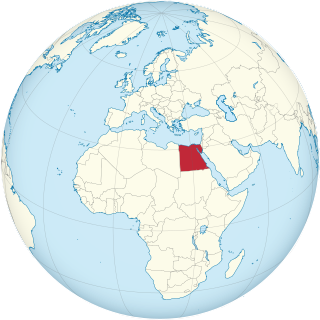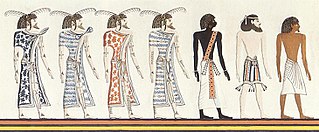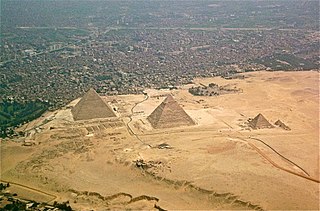
Thebes, known to the ancient Egyptians as Waset, was an ancient Egyptian city located along the Nile about 800 kilometers (500 mi) south of the Mediterranean. Its ruins lie within the modern Egyptian city of Luxor. Thebes was the main city of the fourth Upper Egyptian nome and was the capital of Egypt for long periods during the Middle Kingdom and New Kingdom eras. It was close to Nubia and the Eastern Desert, with its valuable mineral resources and trade routes. It was a religious center and the most venerated city during many periods of ancient Egyptian history. The site of Thebes includes areas on both the eastern bank of the Nile, where the temples of Karnak and Luxor stand and where the city was situated; and the western bank, where a necropolis of large private and royal cemeteries and funerary complexes can be found. In 1979, the ruins of ancient Thebes were classified by UNESCO as a World Heritage Site.

Articles related to Egypt include:

The Sea Peoples are a hypothesized seafaring confederation that attacked ancient Egypt and other regions in the East Mediterranean before and during the Late Bronze Age collapse. Following the creation of the concept in the 19th century, the Sea Peoples' incursions became one of the most famous chapters of Egyptian history, given its connection with, in the words of Wilhelm Max Müller, "the most important questions of ethnography and the primitive history of classic nations".
The history of ancient Egypt spans the period from the early prehistoric settlements of the northern Nile valley to the Roman conquest of Egypt in 30 BC. The pharaonic period, the period in which Egypt was ruled by a pharaoh, is dated from the 32nd century BC, when Upper and Lower Egypt were unified, until the country fell under Macedonian rule in 332 BC.

The New Kingdom, also referred to as the Egyptian Empire, was the ancient Egyptian nation between the 16th century BC and the 11th century BC. This period of ancient Egyptian history covers the Eighteenth, Nineteenth, and Twentieth Dynasties. Through radiocarbon dating, the establishment of the New Kingdom has been placed between 1570 BC and 1544 BC. The New Kingdom followed the Second Intermediate Period and was succeeded by the Third Intermediate Period. It was the most prosperous time for the Egyptian people and marked the peak of Egypt's power.

Kamose was the last Pharaoh of the Theban Seventeenth Dynasty. He was possibly the son of Seqenenre Tao and Ahhotep I and the brother of Ahmose I, founder of the Eighteenth Dynasty. His reign fell at the very end of the Second Intermediate Period. Kamose is usually ascribed a reign of three years, although some scholars now favor giving him a longer reign of approximately five years.

Merneptah or Merenptah was the fourth pharaoh of the Nineteenth Dynasty of Ancient Egypt. He ruled Egypt for almost ten years, from late July or early August 1213 BC until his death on 2 May 1203 BC, according to contemporary historical records. He was the first royal-born pharaoh since Tutankhamun of the Eighteenth Dynasty.

The Third Intermediate Period of ancient Egypt began with the death of Pharaoh Ramesses XI in 1077 BC, which ended the New Kingdom, and was eventually followed by the Late Period. Various points are offered as the beginning for the latter era, though it is most often regarded as dating from the foundation of the Twenty-Sixth Dynasty by Psamtik I in 664 BC, following the departure of the Nubian Kushite rulers of the Twenty-fifth Dynasty after they were driven out by the Assyrians under King Ashurbanipal. The use of the term "Third Intermediate Period", based on the analogy of the well-known First and Second Intermediate Periods, was popular by 1978, when British Egyptologist Kenneth Kitchen used the term for the title of his book on the period. While Kitchen argued that the period was 'far from being chaotic' and hoped that his work would lead to the abolishment of the term, with his own preference being the 'Post-Imperial epoch', his use of the term as a title seems only to have entrenched the use of the term.

The Seventeenth Dynasty of Egypt was a dynasty of pharaohs that ruled in Upper Egypt during the late Second Intermediate Period, approximately from 1580 to 1550 BC. Its mainly Theban rulers are contemporary with the Hyksos of the Fifteenth Dynasty and succeed the Sixteenth Dynasty, which was also based in Thebes.
Ankhwennefer, also known as Ankhmakis, was the successor of Horwennefer, a rebel ruler who controlled much of Upper Egypt during the reigns of Ptolemies IV and V. His rule lasted from approximately 200 to 186 BC.

The Libu were an Ancient Libyan tribe of Berber origin, from which the name Libya derives.

The Great Karnak Inscription is an ancient Egyptian hieroglyphic inscription belonging to the 19th Dynasty Pharaoh Merneptah. A long epigraph, it was discovered at Karnak in 1828–1829. According to Wilhelm Max Müller, it is "one of the famous standard texts of Egyptology... [and has been] ... one of the greatest desiderata of scholars for many years."

Ramesses II, commonly known as Ramesses the Great, was an Egyptian pharaoh. He was the third ruler of the Nineteenth Dynasty. Along with Thutmose III of the Eighteenth Dynasty, he is often regarded as the greatest, most celebrated, and most powerful pharaoh of the New Kingdom, which itself was the most powerful period of ancient Egypt. He is also widely considered one of ancient Egypt's most successful warrior pharaohs, conducting no fewer than 15 military campaigns, all resulting in victories, excluding the Battle of Kadesh, generally considered a stalemate.
Meryey wasa Berber king of ancient Libya, during the late 13th century BC. He was the son of Ded. His reign was contemporary with pharaoh Merneptah of Egypt. He is mentioned as the architect of a major military alliance amongst his nation, the Meshwesh, Lukka, and the Sea Peoples known as the Ekwesh, Teresh, Shekelesh, and the Sherden. This confederacy went to war against Merneptah in the western delta during the 5th and 6th years of his reign.

The Twentieth Dynasty of Egypt is the third and last dynasty of the Ancient Egyptian New Kingdom period, lasting from 1189 BC to 1077 BC. The 19th and 20th Dynasties together constitute an era known as the Ramesside period. This dynasty is generally considered to mark the beginning of the decline of Ancient Egypt at the transition from the Late Bronze to Iron Age. During the period of the Twentieth Dynasty, Ancient Egypt faced the crisis of invasions by Sea Peoples. The dynasty successfully defended Egypt, while sustaining heavy damage.

The Twenty-fifth Dynasty of Egypt, also known as the Nubian Dynasty, the Kushite Empire, the Black Pharaohs, or the Napatans, after their capital Napata, was the last dynasty of the Third Intermediate Period of Egypt that occurred after the Nubian invasion.

The Merneptah Stele, also known as the Israel Stele or the Victory Stele of Merneptah, is an inscription by Merneptah, a pharaoh in ancient Egypt who reigned from 1213 to 1203 BCE. Discovered by Flinders Petrie at Thebes in 1896, it is now housed at the Egyptian Museum in Cairo.
Colleen Darnell is an American Egyptologist, whose expertise includes Late Period uses of the Underworld Books, ancient Egyptian military history, the literature of New Kingdom Egypt, and Egyptian revival history.

The Western Desert of Egypt is an area of the Sahara that lies west of the river Nile, up to the Libyan border, and south from the Mediterranean Sea to the border with Sudan. It is named in contrast to the Eastern Desert which extends east from the Nile to the Red Sea. The Western Desert is mostly rocky desert, though an area of sandy desert, known as the Great Sand Sea, lies to the west against the Libyan border. The desert covers an area of 680,650 km2 (262,800 sq mi) which is two-thirds of the land area of the country. Its highest elevation is 1,000 m (3,300 ft) in the Gilf Kebir plateau to the far south-west of the country, on the Egypt-Sudan-Libya border. The Western Desert is barren and uninhabited save for a chain of oases which extend in an arc from Siwa, in the north-west, to Kharga in the south. It has been the scene of conflict in modern times, particularly during the Second World War.

Nubia is a region along the Nile river encompassing the area between the first cataract of the Nile as well as the confluence of the blue and white Niles or, more strictly, Al Dabbah. Nubia was the seat of several civilizations of ancient Africa, including the Kerma culture, the kingdom of Kush, Nobatia, Makuria and Alodia.

















